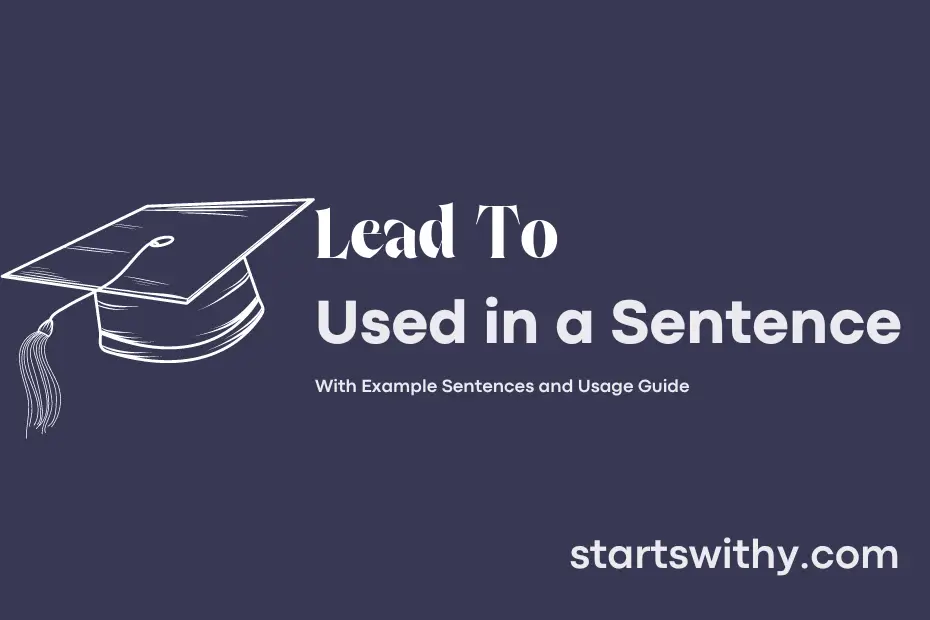Have you ever wondered how one action can directly result in a particular outcome? This cause-and-effect relationship, known as “lead to,” is a common phrase that describes the connection between an action and its consequences.
When something “leads to” a certain outcome, it means that the initial action directly causes or brings about that specific result. This phrase is often used to explain the sequence of events or how one thing can trigger another, resulting in a cause-and-effect relationship.
7 Examples Of Lead To Used In a Sentence For Kids
- Long hours of studying can lead to tiredness.
- Eating too many chocolates can lead to tooth decay.
- Not wearing warm clothes can lead to catching a cold.
- Playing outside in the sun without sunscreen can lead to sunburn.
- Not drinking enough water can lead to dehydration.
- Running around too much can lead to getting tired.
- Not listening to the teacher can lead to missing important information.
14 Sentences with Lead To Examples
- High levels of stress can lead to poor academic performance.
- Procrastination can lead to missed deadlines and late submissions of assignments.
- Skipping classes regularly can lead to difficulties in understanding course materials.
- Neglecting to revise regularly can lead to poor retention of information for exams.
- Participating in too many extracurricular activities can lead to burnout and fatigue.
- Not adapting to a balanced diet can lead to health issues and a lack of focus in studies.
- Engaging in plagiarism can lead to serious consequences like failing a course or being expelled.
- Mismanaging time can lead to cramming and pulling all-nighters before exams.
- Ignoring feedback from professors can lead to repeating the same mistakes in future assignments.
- Not seeking help for mental health issues can lead to a decline in overall well-being.
- Relying solely on last-minute studying can lead to lower grades in exams.
- Choosing a major based on external pressure rather than personal interest can lead to dissatisfaction with academic choices.
- Not networking with peers and professors can lead to missed opportunities for internships and job placements.
- Failing to manage finances properly can lead to financial stress and affecting academic performance.
How To Use Lead To in Sentences?
Lead To is a phrasal verb that is commonly used in English to indicate a cause-and-effect relationship between two events or actions. It essentially means that one action or event results in the occurrence of another.
Here is a simple guide on how to use Lead To in a sentence:
-
To use Lead To, start with a subject followed by the verb “lead” and then the preposition “to”.
Example: “Eating unhealthy food can lead to health problems.” -
Lead To is often used to explain the consequences of certain actions or decisions.
Example: “Neglecting your responsibilities can lead to serious consequences.” -
Make sure to place the action or event that causes something first in the sentence, followed by “lead to”, and then mention the effect or result.
Example: “Proper time management can lead to increased productivity.” -
When writing or speaking, remember to use “lead to” when discussing a causal relationship between actions, events, or situations.
Example: “Skipping breakfast can lead to feeling tired later in the day.”
By following these simple guidelines, you can effectively use Lead To in your sentences to show the connection between various actions and their outcomes. Practice using this phrasal verb in different contexts to improve your English language skills and communication.
Conclusion
In conclusion, understanding how to construct sentences that effectively lead to a clear conclusion is crucial for effective communication. By using transitional phrases and logical connections in writing, such as “as a result” or “therefore,” we can guide readers through our ideas in a coherent manner. This not only helps to maintain the flow of our writing but also ensures that our message is conveyed with clarity and precision.
Furthermore, mastering the art of constructing sentences that lead to a clear conclusion can enhance the overall quality of our writing, making it easier for readers to follow our thoughts and reach the intended understanding. By consciously structuring our sentences to build towards a definitive endpoint or summary, we can create more engaging and persuasive content that effectively conveys our message.




